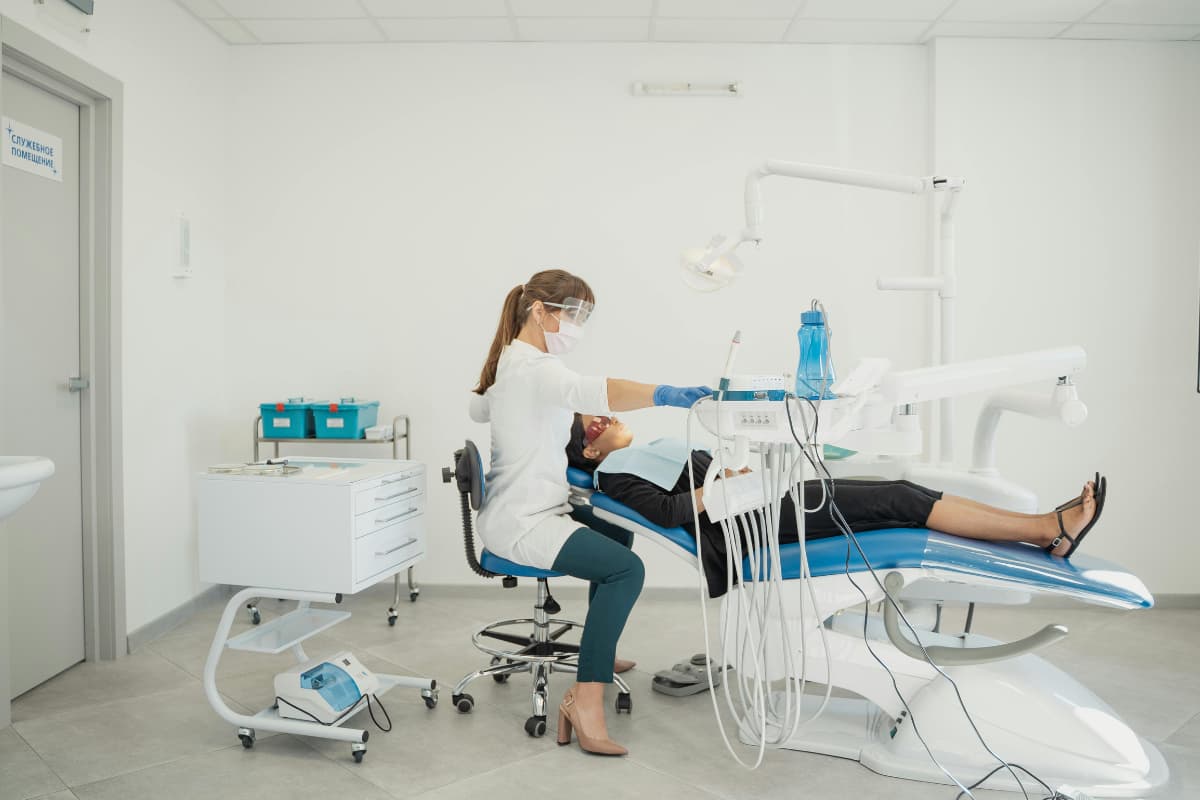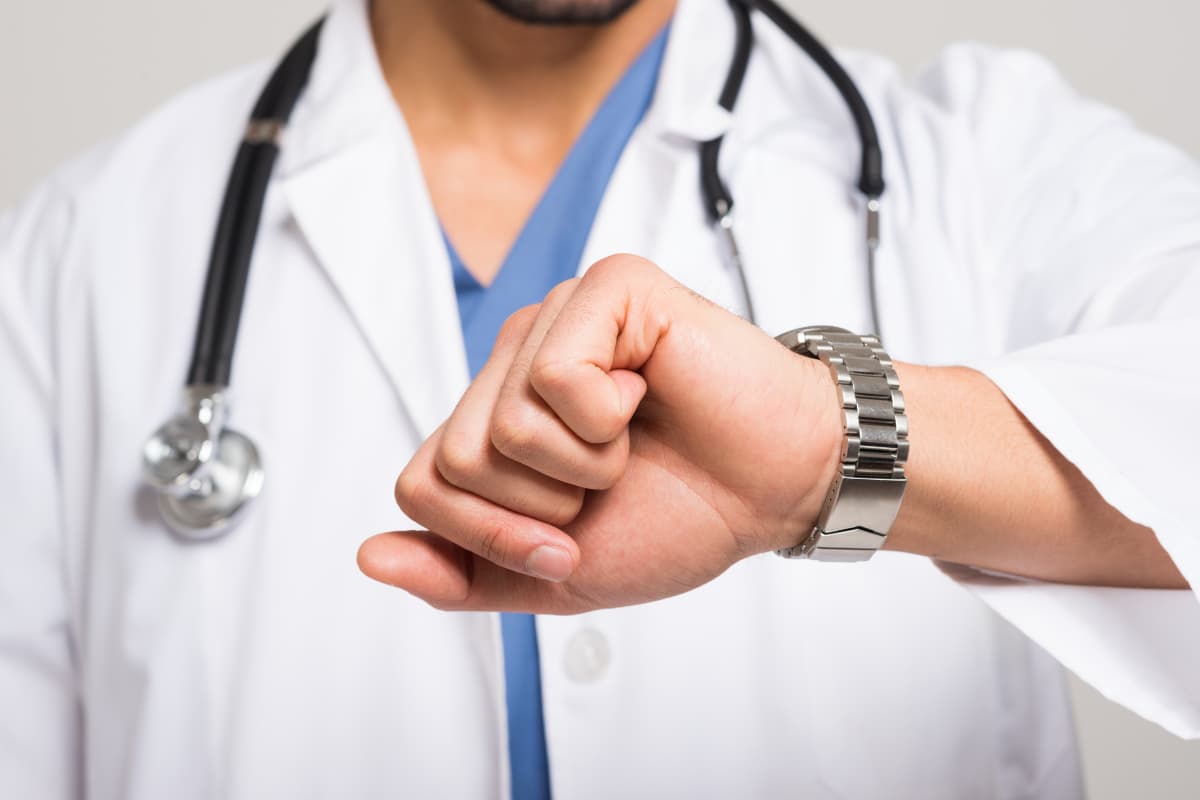What does the telematics infrastructure consist of?
The telematics infrastructure consists of several essential components that work together seamlessly to ensure the smooth exchange of medical data. This includes:
1. Electronic health card (eGK)
The electronic health card (eGK) plays a central role in TI. It stores insurance master data and gives patients access to various digital health services. Through the eGK, patients can identify themselves with doctors and hospitals.
2. Electronic health professional card (eHBA)
The eHBA is a chip card that medical personnel such as doctors and dentists use for authentication within TI. It allows the secure signing of medical documents and the encrypted exchange of data between various healthcare providers.
3. Connectors
Connectors are special devices that serve as a secure interface between local systems in practices, pharmacies, hospitals and the TI infrastructure. They encrypt data transmission and ensure that only authorized users have access to the information.
That means: Only users who have an electronic health professional ID and a practice card can access the connectors. This ensures the security and confidentiality of medical data.
note: Security certificates are also required to guarantee the integrity and authenticity of connections. Connectors contain such security certificates, which expire after a certain period of time, usually 5 years. They must then be renewed or replaced in order to continue working safely in the TI.
4. Card terminals
These terminals are responsible for reading the electronic health card (eGK) and the electronic health professional card (eHBA). They are used in medical institutions to verify the identity of patients and professionals and provide access to TI services.
5. VPN access service
The VPN access service ensures an encrypted connection between the individual TI components. This virtual private network (VPN) protects data transmissions from unauthorized access and ensures the security of transmitted information.
6. Practice Management System (PVS)
The practice management system (PVS) is software that is used in medical institutions to manage patient data. It is directly connected to TI and provides access to electronic health records and other digital healthcare services.
7. Communication services such as KIM
Medical Communications (KIM) is a secure email service that makes it easy to exchange medical documents and information between healthcare providers. KIM ensures fast, secure and privacy-compliant communication.
8. Electronic health record (ePA) and electronic prescription (ePrescription)
The ePA enables patients to digitally manage their health data and share it with various healthcare providers as needed. The eRecipe digitizes the prescription process and reduces the amount of paper required in practices and pharmacies, which optimizes the workflow and protects the environment.
Important for patients to know: Patients have full control over their EPA and decide which information they release and which doctors or institutions it is forwarded to. With patient consent, doctors can access the ePA to view relevant medical information and optimize treatment accordingly.
9. Emergency data management (NFDM)
Emergency data management (NFDM) is an important application within the telematics infrastructure that makes it possible to store and retrieve vital medical information in an emergency.
This application helps doctors and healthcare professionals have immediate access to a patient's critical health information, such as allergies, chronic conditions, and current medications, in emergency situations. By quickly accessing this data, life-saving decisions can be made and the best possible care can be guaranteed. The NFDM thus improves emergency care and helps to minimize risks and medical errors.
By the way: All elements of TI mentioned so far are mandatory.
Note on the ePA: So far, only very few patients have applied for the use of ePA. From 2025, it is expected that more and more patients will have an ePA that needs to be filled. But even now, an ePA must be filled as soon as it has been requested by the patient.
10th Patient Data Protection Act (PDSG)
The Patient Data Protection Act (PDSG) regulates data protection and security within the telematics infrastructure. It ensures that all parties involved comply with legal requirements and that patients' privacy is protected.
The PDSG prescribes exactly how health data may be collected, stored, and shared, and sets strict rules for access to this data. It also includes measures to ensure data security, such as the use of encryption and regular security checks.
11. Digital tools
In order to make everyday practice more efficient, we offer Providers like Nelly digital tools that complement the functionalities of the practice management system (PVS) in areas such as billing and anamnesis. These software solutions make daily work much easier by automating and simplifying administrative tasks. This allows healthcare professionals to spend more time caring for patients while ensuring that all billing is accurate and timely.

Data protection & security: How secure is the telematics infrastructure?
We have already touched on the topic of data protection and security. But we know that this issue is a key issue.
Therefore, here is a summary that includes 2 other aspects that have not been addressed before:
- Encryption technologies: All data transmissions within TI are heavily encrypted to ensure protection against unauthorized access.
- Electronic health professional cards (eHBA) and practice cards (SMC-B): These cards authenticate users and only allow authorized persons to access sensitive medical data.
- Validity and renewal of safety certificates: Connector security certificates are valid for 5 years and must then be renewed or replaced to ensure the security of connections.
- Patient Data Protection Act (PDSG): The PDSG ensures that health data is collected, stored and shared in accordance with strict legal requirements. It sets out comprehensive measures to protect patients' privacy.
- Regular security updates: Regular software updates close security gaps and ensure that TI components always meet the latest safety standards.
- maintenance services: Scheduled maintenance work guarantees the continuous safety and functionality of TI.
What does the telematics infrastructure cost?
The costs for the telematics infrastructure (TI) vary depending on the size of the practice and the components required. They include the purchase of connectors, card readers and VPN access services as well as ongoing costs for updates and maintenance. However, statutory health insurance funds reimburse a large part of these costs to support the introduction of TI. It is advisable to contact the respective professional associations or health insurance companies for the exact reimbursement levels.
Who covers the costs of connecting practices to TI?
The costs of connecting practices to the telematics infrastructure (TI) are largely covered by statutory health insurance funds. Practices receive reimbursements both for initial equipment and for ongoing operations. Doctors and dentists receive monthly flat rates, which vary depending on the size of the practice and the TI components used.

Special features of specialist areas in the telematics infrastructure
Depending on the subject area, applications and requirements differ:
a) Are there any special features of the telematics infrastructure in the area of care?
Yes, TI in the area of nursing has some special features compared to “general telematics”, which are specifically tailored to the needs and work processes of care facilities. Let's take a quick look at these special features:
1. Commitment to connect
While the connection to TI has been mandatory for doctors, dentists, psychotherapists, hospitals and pharmacies since 2015, this obligation for care facilities will only apply from July 2025. This delay allows gradual integration and adjustment to take into account specific needs of the care sector.
2. Areas of application
General telematics primarily includes applications such as insurance master data management (VSDM), electronic health records (ePA), electronic medication plans (eMP), emergency data management (NFDM) and e-prescription. In the area of care, however, there are additional specific applications such as digital care applications (DiPA) and digital care advice that is specifically tailored to the needs of people in need of care and the work processes of care facilities.
3. Model programs
In contrast to general telematics, which was implemented largely uniformly and simultaneously in various medical areas, special model programs were set up for nursing. These programs, such as the model range in accordance with § 125 SGB XI, test the integration of care facilities into TI and develop standards and best practices that are intended to meet specific care requirements.
4. Communication and data exchange
While general telematics aims to improve data exchange between different medical institutions and increase efficiency in healthcare, there is a particular focus on cross-sectoral communication in the area of care. Applications such as KIM (communication in the medical sector) and the planned Telematics Infrastructure Messenger (TIM) are designed to optimize the flow of information between care facilities, doctors and pharmacies and to reduce the use of outdated means of communication such as fax.
5. Data protection and security
Strict privacy policies and security protocols are integral parts of TI to ensure the confidentiality and integrity of patient data. These aspects are particularly important in the area of care, as care facilities often handle highly sensitive data from particularly vulnerable patient groups. TI in Nursing therefore intensifies data security and the protection of personal information
b) Are there any special features of the telematics infrastructure in the area of physiotherapy?
Yes Similar to telematics in the care sector, TI also has specific features in the area of physiotherapy. Let's look at them together briefly:
Commitment to connect
In contrast to other health professions, which are already committed to joining TI, this will only apply to physiotherapists from 2026, but since July 2021, there has been the option to join on a voluntary basis. This delay allows gradual integration and adaptation to the specific needs of physiotherapy.
Did you already know:
Since January 1, 2024, physiotherapy practices have received a monthly flat rate of 200.22 euros and a surcharge of 7.48 euros per employee with an electronic health professional ID.
c) Are there any special features of the telematics infrastructure for dentists?
There are also some special features for dentists at TI, which we briefly present here:
1. Electronic dental health professional card (eDentist-HBA)
A central aspect is the Electronic Dental Health Professional Card (eDentist-HBA), which is specifically tailored to the requirements of dentists and enables the use of dentist-relevant TI services. In addition, dentists have special requirements for the documentation of treatment plans, X-ray images and dental status, which must be taken into account in the electronic health record (ePA).
2. Integration of X-ray images
Another important point is the integration of X-ray images. Dental practices must be able to integrate radiographs and other imaging techniques into the EPA. This requires special interfaces and software solutions that are designed to process and store these large amounts of data.
3. Specific billing processes
The billing processes in dental practices are also specific and differ from those of other medical disciplines. TI supports the submission of treatment and cost plans to health insurance companies, which may differ from general medical billing procedures.
4. Additional safety measures
Dental practices must also take additional security measures to ensure the confidentiality and integrity of sensitive dental data. This includes specific privacy policies and security protocols for handling X-ray images and other sensitive information.
5. Specific legal requirements
Finally, there are legal requirements that apply specifically to dental practices and may differ from the general requirements for doctors. This may include, for example, compliance with certain documentation requirements or the use of special sets of forms.
Assistance in setting up the telematics infrastructure
In order to successfully implement and use the telematics infrastructure (TI), practices, hospitals and pharmacies have numerous support options available.
IT service providers offer special training programs that train medical staff how to use TI and its applications. This training ensures that all employees can use the systems effectively. In addition, IT service providers provide technical support to help install, configure, and maintain TI components.
There are also numerous online resources, such as manuals, tutorials, and FAQs, which provide valuable information and practical tips for using TI. By taking advantage of this support, healthcare institutions can take full advantage of TI and ensure a smooth implementation.
conclusion
TI is transforming the German healthcare sector by enabling secure and efficient digital networking of all players. It improves the exchange of medical data and increases treatment quality and efficiency. The introduction of TI shortens communication channels, reduces incorrect handling and reduces administrative costs.
To make optimal use of TI, practices, hospitals and pharmacies should provide regular training in addition to mandatory measures, actively use TI's advanced features and ensure that all systems are always up to date.
In conclusion, with support from IT service providers and compliance with data protection guidelines, healthcare institutions can take full advantage of TI and further improve the quality of their services.
Now you too can create a digital workflow in your practice. We advise It is free of charge and without obligation.
Common questions
What does telematics infrastructure mean?
The telematics infrastructure (TI) is a digital healthcare network that enables the secure exchange of medical data between doctors, hospitals, pharmacies, and other healthcare providers.
Is telematics mandatory?
Yes, the telematics infrastructure (TI) is mandatory for all healthcare providers in Germany. Physicians, dentists, psychotherapists and other healthcare providers must join TI in order to use certain legally required applications, such as insurance master data management and electronic health records.
Who has access to the telematics infrastructure?
All approved healthcare providers, such as doctors, dentists, psychotherapists, pharmacies and hospitals, have access to the telematics infrastructure (TI). Access is secured by health professional cards and institutional cards (SMC-B), which verify the identity of users. Patients also have limited access to their own data via certain applications, such as electronic health records (ePA).
What data does the telematics infrastructure collect?
The telematics infrastructure (TI) collects a wide range of medical and administrative data, including:
- Insurance master data (e.g. name, date of birth, address)
- Electronic health records (ePA)
- Electronic medication plans (eMP)
- Emergency data
- Doctor's letters and findings
- e-recipes
- Billing data and regulations
This data is exchanged securely and encrypted between healthcare players
Which TI connectors are there?
There are several providers of TI connectors that are approved by Gematik. The most well-known connectors include:
- Secunet connector: A secure and reliable connector commonly used in medical practices.
- CGM (CompuGroup Medical) connector: Offers comprehensive solutions for connecting to TI.
- Rise connector: Another certified connector that is used to connect to TI.
These connectors ensure the secure connection of practice management systems to the telematics infrastructure and enable data exchange between healthcare players
What to do if there is an error message from a connector?
If you receive a connector error message, the following steps should be taken:
- Note the error message: Write down the exact error message and error code.
- Restart connector: Try restarting the connector. Restarting can often solve the problem.
- Check Internet connection: Make sure that the Internet connection is stable and functional.
- Consult user manual: Refer to the connector user manual for specific troubleshooting instructions.
- Contact support: Contact the connector manufacturer's technical support. Make sure you have all relevant information available (error message, connector model, etc.).
- Perform system updates: Make sure all software updates and patches are installed.
If problems persist, you should contact your IT service provider who can help you further troubleshoot them.











